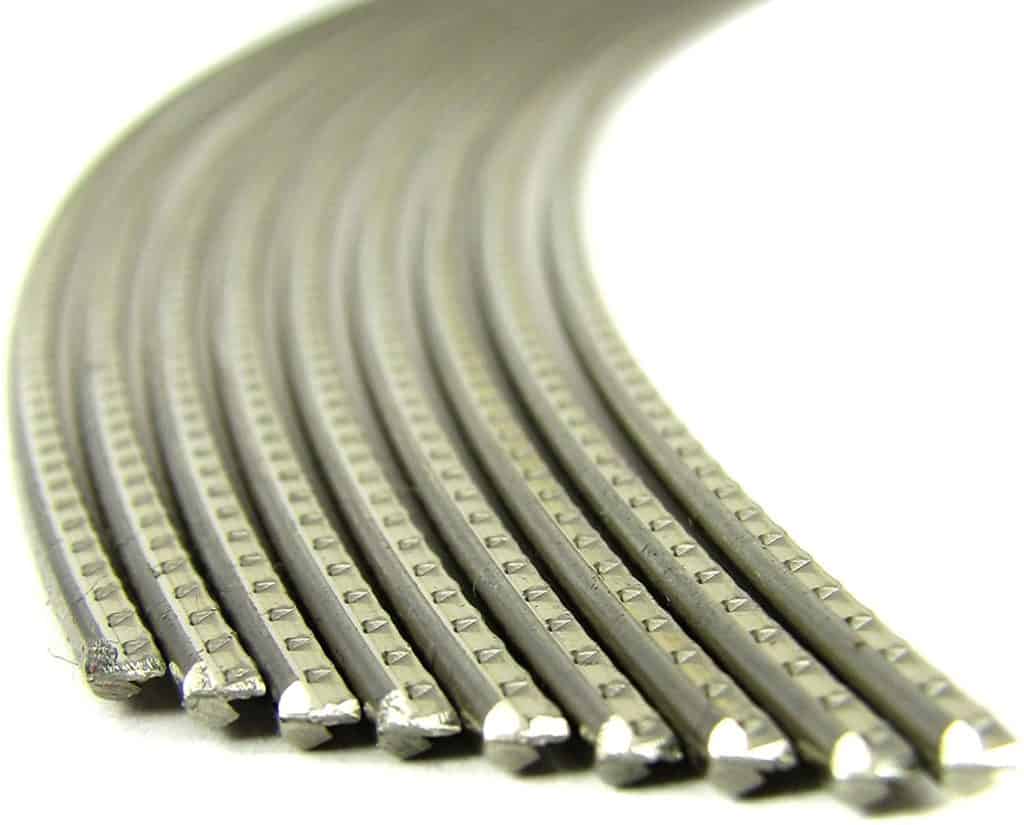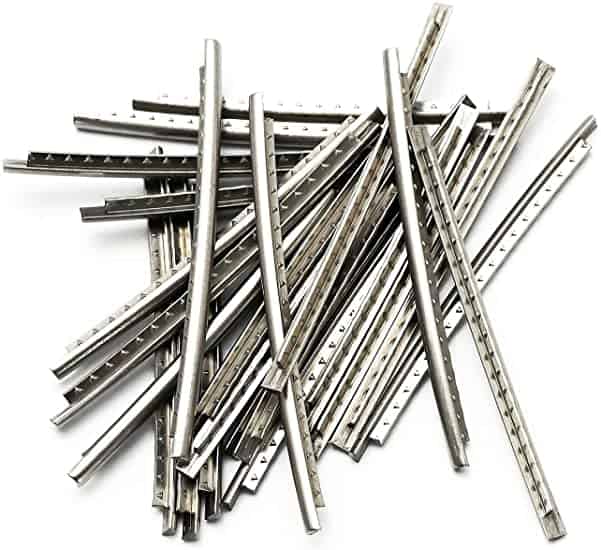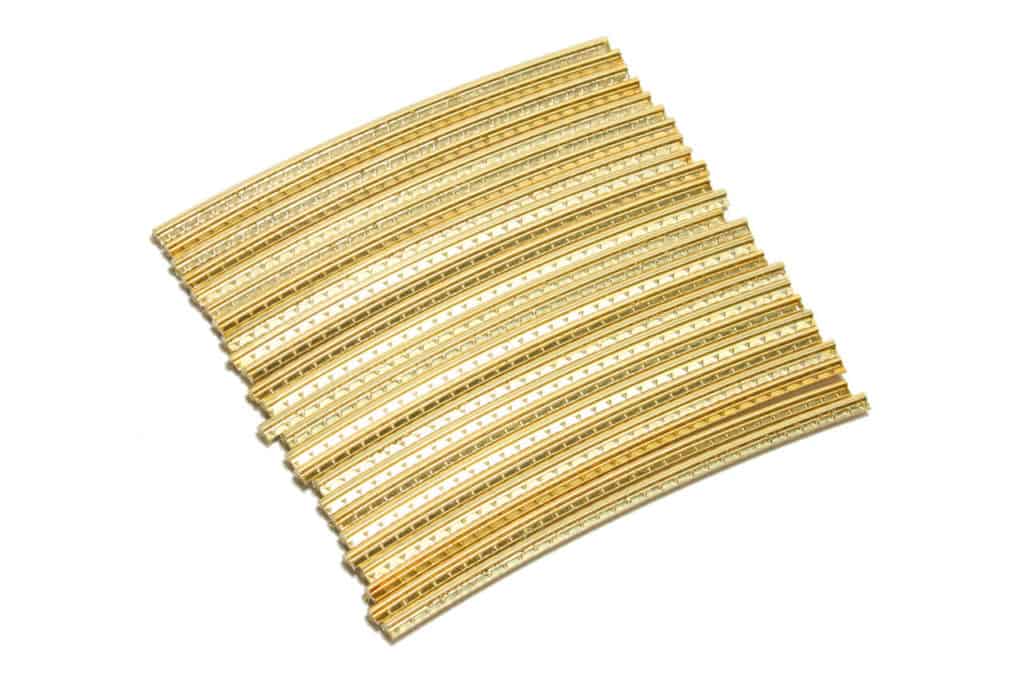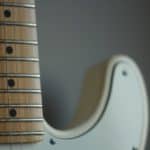Frets are one of the fundamental parts of a guitar that many of us really take for granted.
Did you know there are many different fret sizes and that these are not arbitrary?
Many players prefer some over the other and they have very strong reasons for their choices.
But do frets actually affect the tone and playability of a guitar? Here is a short answer:
Fret size and material do affect tone and playability. Wider and taller frets are easier to play with, however, have worse intonation than thinner ones. Shorter frets increase friction with the fingerboard making bending harder. With materials, durability and smoothness are the main features to look for.
If you want to know more about the different kinds of frets there are, in this article, I will talk in detail about them and their effect on tone.
After that, I will list and describe the most common sizes and materials for frets.
Finally, I will give you my conclusions and recommendations about how you should approach the process of picking a new guitar, based on their frets.
Are you ready to get started?
Let’s go!
Does fret size affect tone?
Fret size, like many other components in the complex equation a guitar’s tone is, does affect the sound of the instrument. Bigger frets are known to provide a rounder bigger tone. However, there is a tradeoff with note intonation. Narrower frets are more precise and said to have a more shimmery tone.
The slight “muddiness” in note precision bigger frets have can, however, be considered as just a characteristic of their tone and not a drawback.
As with everything in art, what sounds wrong to someone might be what others are looking for.
How much does fret size affect tone?
Quantifying how much a single component of a guitar affects its final tone is a very complex task that would require extensive scientific research.
What I can offer you today is just a recompilation of empirical evidence and opinions a wide array of players expressed.
The effect of fret size on tone is mostly a matter of intonation and not that much an “EQ” thing as many other components of the guitar generate.
Since frets are what defines the note your playing, their effect is fundamental for the overall sound. Slight changes in intonation might make or break the experience for sharp ears.
Jumbo frets, when contrasted against the smallest kind you could find, such as 6230, will sound bigger, rounder, and less precise in pitch in a noticeable way.
As you go through the in-betweens, your mileage may vary, and you might find blends that better suit your ear if you are not a tone extremist.
Does fret size affect playability?
Frets have a big impact on the playability of the guitar. Bigger frets will allow you to have a softer touch on the strings. Narrower frets will require some more digging into the strings to get things to sound good. Bending will be easier the higher the frets are, whether they are wide or thin.
Narrow frets also will leave some extra finger space to be played, especially on higher pitches. This might be something to consider for some players.
How much does fret size affect playability?
Many players might take this component of the guitar for granted, however, a lot of their playing style will be directly influenced by it.
In my opinion, fret size can have a rather noticeable impact on the playability of an instrument.
It’s not that you won’t ever get used to bigger or smaller frets it’s that you will probably prefer one or the other.
Players with stronger bigger fingers will likely enjoy the benefits that narrower frets will give them, especially when reaching for higher pitches.
Guys with smaller hands like me are probably benefitted from wider frets which allow us to have a lighter touch while playing, while not having any problems when fretting high notes.
These are just stereotypes, however, and as much as many will use it as an excuse, ergonomics are not really a defining factor for technique.
Different players will have different techniques and will prefer different features. Something as personal as fret size should be a matter of concern.
Does fret material affect tone?
Fret material can have an effect on tone as every other variable that makes a guitar. This component is involved in transmitting vibrational energy to the neck and the rest of the guitar. How much a fret is worn out will also change its sound as much as the material it was made with.
There are not many usual alternative materials for guitars, and the differences between them are slight, so you should not worry that much about their effect on tone.
How much does fret material affect tone?
The tone of a guitar will not be greatly affected by the material of its frets. As long as we are comparing among the most common ones and nothing out of the ordinary. Fret size and shape will probably have a bigger impact on tone than its composition or manufacturing process.
Being this said, some players argue that stainless steel frets sound a bit more full and as if they transmitted vibrations deeper into the guitar.
Does fret material affect playability?
Fret material can have an effect on playability. Smoother mediums such as polished stainless steel will probably feel less resistant than worn-out old frets. However, this is more a testament of condition than of actual choice of substances. Fret size has a bigger influence on playability.
How much does fret material affect playability?
The effect of fret material on the playability of a guitar is minimal and not likely to be felt by most players.
Unless comparing against extremely different kinds of components, a normal player would hardly distinguish between silver nickel frets and stainless steel ones.
The biggest concern, when thinking about fret material should always be durability and maintenance, rather than tone or playability.
Most common fret sizes and their effect on tone and playability
There are many different common sizes for frets, and manufacturers tend to come up with their own versions now and then.
Having a broad knowledge about what are the alternatives and how they look like compared to each other will be helpful on your guitar journey.
Here is a diagram with some common fret sizes:

And now, here’s a list of some of the most common kinds of frets used by many builders:
6230 Smallest (.078″ x .043″)
This fret size is nowadays kind of rare. It was commonly used in vintage guitars, particularly Fenders built in the ‘50s.
Modern guitars tend to use wider frets.
In terms of playability and tone, 6230 frets will offer you great intonation and spacing between frets.
Players who like fighting a bit the fretboard to make notes ring will enjoy these frets.
6105 Modern narrow and tall (.090″ x .055″)
These frets are a modern approach to the vintage 6230. They are similar in width to their older brothers, however, they are slightly taller.
Its increased height makes bending easier while maintaining all the intonation and spacing benefits of narrower frets.
6150 Vintage jumbo (.102″ x .042″)
Vintage jumbo frets are in an awkward position. They are a lot wider than 6230, but also shorter.
Their design makes them easy to play with, but they have a not as precise intonation, and they are probably the worst from this bunch for bending.
This combination of factors makes them not very popular among modern players.
6130 Medium jumbo (.106″ x .036″)
These frets are Gibson’s choice for their more modern guitars. Medium jumbos are rather wide, but the shortest of this list.
Their width makes them great for their easiness to play, however, intonation is compromised.
Being shorter implies that the fingers will usually come more in contact with the wood of the fingerboard, adding some friction when bending, for instance.
It’s not that you couldn’t bend at all with these frets, in fact, Gibson wouldn’t pick them if that were the case. However, you will have to get used to them if you come from taller alternatives.
6100 Jumbo (.110″ x .055″)
Jumbo frets, as their name implies, are the widest and tallest of them all. There’s nothing much to say about it.
Their size makes playing with them extremely easy, and their height reduces friction and favors bending.
Intonation is not their strong point, nor is, of course, spacing between frets.
Players will smaller hands will probably find these uncomfortable.
Most common fret materials and their effect on tone and playability
The material of the frets is, perhaps not as important as its size, but it has an impact on the tone and playability of the instruments.
Here are the 3 most common materials for frets:
Nickel silver

Nickel silver or German silver is a compound of 80% nickel, 18% copper, and the remaining 2% comprised of small amounts of other metals. As you can see, it has no silver in it, and the name can be a bit misleading.
This is the most common material used all around the world for frets, and it’s easy to work with.
It is pretty durable, however, extensive playing will wear down nickel silver frets with time, requiring a level or re-fret with time.
In terms of tone, I will consider this the baseline, because is what most likely all of your guitars have.
Stainless steel

Stainless steel is a harder material than nickel. It requires different tools and is harder to work with.
This, clearly, makes it a more expensive alternative.
In terms of feel, stainless steel frets are glassy and very smooth to play with. Its hardness guarantees longevity, so fewer levels, and refrets will be required over time.
In terms of tone, some players argue that stainless steel transmits the vibrations of the strings deeper into the neck and that it sounds fuller.
EVO gold

EVO gold is a copper alloy used as an alternative to nickel because many people have nickel allergies.
These are harder than nickel silver frets, but not as tough as stainless steel ones.
You can expect their durability to be in between those 2.
Another reason some people gravitate towards this material is its looks. As the name suggests, EVO gold frets are golden and retain that look forever, even if worn down.
What fret size is the easiest to play?
Jumbo frets are the easiest to play due to their size allowing for a lighter touch on the strings. However, this bigger option of fretwire has its drawbacks when playing higher up the fingerboard since the space between frets will be noticeably reduced, requiring the player to be more precise.
This is, however, a generalization, and player preferences have a big weight on this matter.
Maybe thinner, taller or shorter frets will be particularly easier for your hands and technique.
I encourage you to try out as many as you can before making any conclusions.
Does fretwire have an effect on intonation?
Fretwire has a noticeable impact on intonation. Wider frets have a worse overall intonation which gives a slightly imprecise, in terms of tone, mood to their sound. Narrower frets have laser-sharp intonation, and although harder to play, will allow for the most precise players to sound perfect.
The effect on intonation different fret sizes have comes from the distance to where the actual note is placed on the fingerboard with respect to where the string sits on the fret when played. Wider frets will have a bigger deviation from the pitch center.
What is the best fret material/wire?
Some players will argue that the best material for frets is stainless steel due to its hardness and durability. However, every one of the most common materials has its upsides. Nickel silver is cheap, very available, and easy to work with. EVO gold is harder and hypoallergenic.
Also, the golden look of EVO gold will surely complement some guitar’s aesthetics, and be the main reason for its usage.
What are the best frets for bending?
The best frets for bending are the taller ones, not taking into account how wide there are. Of course, jumbo frets will be considered the kings of bending, however, any other tall ones, such as 6105 modern narrow and tall frets will also give very nice bend experiences.
Action, string gauge, and scale are other important factors that determine how hard bending will be in the instrument, and its overall feel, what’s most important.
Some players will prefer harder bends, while others will be happier with less effort.
Conclusions and recommendations
Whether you are looking for a new guitar or planning on building or having one built, getting to know, at least at a high level how guitar frets work is, in my opinion, something that will help you make a better informed final decision.
However, here in GearAficionado, I always say that you should try out every instrument before buying it if you have the chance.
I don’t think anyone can really understand the sound and feel of all these different guitar frets without getting to try them live. At least try the ones that you think might work out better for you.
If it’s within your reach, try to get to play completely different guitars to clearly understand where the variation lies, and then start checking out ones closer to the one you preferred the most.
Finally, don’t forget to have fun. Technicalities for some people get the joy out of getting a new piece of gear. You don’t have to know it all about something that makes you smile. Just go and play the instrument that feels best to you.

Hello there, my name is Ramiro and I’ve been playing guitar for almost 20 years. I’m obsessed with everything gear-related and I thought it might be worth sharing it. From guitars, pedals, amps, and synths to studio gear and production tips, I hope you find what I post here useful, and I’ll try my best to keep it entertaining also.





